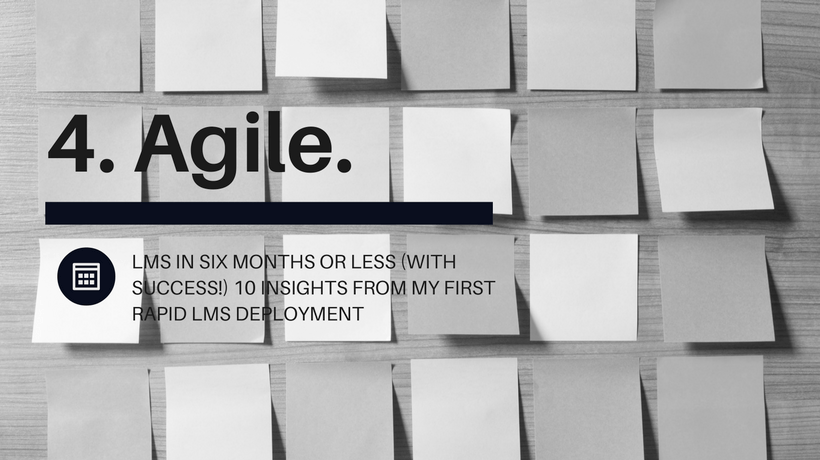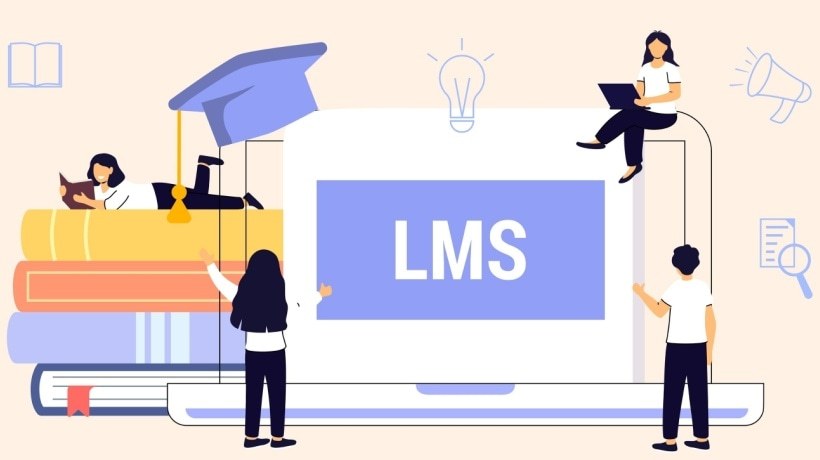Learning Management System Success: Trying Agile Methodologies
I still remember my inner groan when a new Technology team came on to support the implementation. My mind immediately brought up questions like “It’s too late for this”, “I don’t have time to catch them up and finish the new system training”. However, because of my trust in the organization and leadership, I was able to let go, let them guide me, and that new supporting Technology team saved the day.
Disclaimer: I have not been formally trained in Agile, and I am mainly describing the process based on my experience and what I know now. Looking at you, Agile purists…
1. Facilitated Agile Sessions
Brainstorming Session
My Agile tech team facilitated several exercises that helped determine the project roles, responsibilities, values, goals, priorities, and even risks. In fact, the first Agile facilitated session was a few days after the project kick-off meeting.
The roles and responsibilities session included the project executive sponsors, senior members of the Technology team, interim Learning and Development Director, Director of Internal Communications, and the VP of HR (this would probably be the CLO if your organization has one). The executive presence showed support and helped get the project off to the right start.
Each session facilitated by the enterprise Agile coach had a purpose, a defined process, the right members of the project team, a lot of sticky notes, and Sharpies, of course. There are several kinds of Agile sessions the team can go through, but we did this for at least the project values and risks, user stories and slices, MoSCoW method session, and even mini-retrospectives.
Define The Purpose
The purpose of exercise was to take the high-level project roles and responsibilities and determine, through consensus, who on the internal project team would be in what role. This also gave us a visual view of the workload balance to see what project team member would need the most support and/or where some responsibilities could shift.
This was my first introduction to a facilitated Agile exercise and admit to major resistance when I heard “close your laptops, please”. I know I’m not the only one whose day gets filled with meetings (often back-to-back) and when you’re looking at a large-scale, rapid Learning Management System deployment every minute is sacrosanct. But our amazing enterprise Agile coach had me at “to get the most value out of this meeting and leave knowing what you role really means”.

Agile Coach Defines Process
Once the collective “no laptop rule” grumbles subsided, the Agile coach set the session expectations, talked through activities we would be led through, and what would come out of the meeting.
Next, the Agile facilitator wrote each Learning Management System implementation project role that had been previously defined on a whiteboard. The group was then asked to name who would be in what project team role. A lively discussion ensued, but we set role expectations through group consensus within 30 minutes.

The last step of this session process was to write out each specific task we could think of for each role. We were given 10 minutes and our enterprise Agile coach rejected any sticky note that was too vague, general, or broad. I’d say 98% of the group was new to Agile.
The tasks didn’t have to be completely broken down, but I did struggle here (let’s just say my crumpled up sticky pile was quite large…) The right Agile coach should guide you with question prompts when they see the struggle/resistance. The enterprise Agile coach I worked with kept asking me questions like “But what is involved in determining Learning Management System configuration?”, “How do you figure out the Learning Management System configuration for that feature?”, “What does configuration even mean?”. Don’t take this personal and you’ll end up learning a crucial part to a successful rapid Learning Management System deployment: How to very quickly understand the tactical level needs without getting lost in the weeds.
Finally, the whiteboard will end up looking something like this and the group can quickly see where more support is needed, who can take on more tasks, etc.

2. Get A Kanban Board
I came into my office area one morning to see a black poster board with painter’s tape marking it into 3 sections. There was a sticky note above each section.
“What’s that?” I asked our Agile Coach who was just putting up the last sticky.
“It’s a kanban board”, they said and then explained that this was how we were going to hold each other accountable to the MoSCoW meeting outcome we had the previous day.
In full transparency, the project team operated without a dedicated project manager, but we made it work. Our kanban board was not fancy at all and, in fact, it’s still the one we use (see below). The kanban board worked for us and that’s all that matters.

The MoSCoW board the project team used (and still uses today for high-level items) is also DIY and also works great for the team.

Our Agile coach then went on to explain the basic concept of a kanban board. I don’t know what stage of resistance/realization I was in at that moment, but I do remember some internal chuckles at how this would never work because “I can’t just do 3 things a day to meet the deadline”. Plus, there was no way I could do “one task completely before moving onto the next”. I had so many excuses from meetings to impromptu questions to bathroom breaks. In the end, I realized that my multi-tasking was very often not letting me completely finish one task a day.
3. Finding The Right Mix Of Agile
The enterprise Agile coaches I work with will cringe if they read this, but I do think that there could be the right balance if you are taking the methods that work best for you and your organization.
It’s possible I’m still in one of the final stages of Agile resistance, but I’m still not ready to become an Agile purist. I do think that Agile can extend to even learning content development, but currently, I’m not sticking to Agile 100%. This was part me and part organizational need, but it’s working for me and the team right now.
One way that Agile was useful for the Learning Management System implementation project was a retrospective where we identified that the user slice we chose was valuable for the Learning Management System administrators because we were able to test out several learning management system features simultaneously. However, it was such a small portion of a population of over 85,000 that we failed to realize the value of more users to help determine system load or even reporting configuration. This is just one example of a lesson learned, but going back I would still make the same choice. The only difference is that I would just ask for more users because I know the Subject Matter Expert would have gladly provided more users for the slice. Retrospectives can bring up simple things like that and it’s important not to be hard on yourself for it.
If I were to be some kind of project management purist I would say the same that I do when I get asked what the best Learning Management System is - the best project management method is the best one for your organization. I am a firm believer in solutions that meet the functional user and organization’s strategic goals.
I am going to go back to transparency and say that a rapid Learning Management System deployment can be a bumpy ride, but it can also be a great learning experience for you. Trust your organization and yourself to either get to a full Agile process or learn how to find the right balance.

The team still has a stand-up and recently I’ve noticed our Agile coach standing back and letting me take the lead. If I’m not there, someone else does it. I realized writing this article that leaving us was the goal all along and while they are greatly missed, this is absolutely the future of work.
I know that learning to be transparent, vulnerable, and put your ego aside is hard, but doing that is key to getting to a full Agile process or even sticking to it after project launch. If vulnerability is new for you, start by watching Brené Brown's TED talk and then go read all her other stuff.
See my last three shared insights below and stay tuned for future articles about the insights I learned during my first rapid Learning Management System implementation.
- Start Before The Official Project Kick-Off.
- Understanding Your Organization’s Goals.
- Building (Or Borrowing) Your Team.
- Set Guiding Principles (And Stick To Them!) For Implementation.
- Establish Governance And Expectations Early.
- Schedule Regular Stakeholder Meetings And Communication.
- Never Assume Anything, Ever.
- Understand Authoring Tools (Native And Cloud-Based).
- Be Your Learner’s Advocate.








